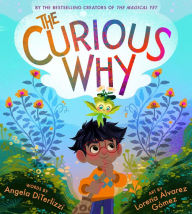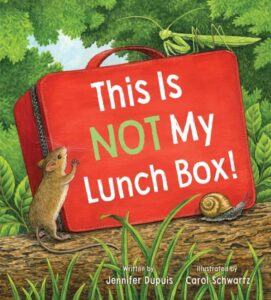32 pages
This month’s PB review is by Ryan G. Van Cleave (Owner/Operator of Only Picture Book) and freelance author/illustrator Kelly Light.
–Ryan’s Review of the Writing–
Being best friends with a yeti might sound like a dream come true—after all, who wouldn’t want to have the “best seat in the house” while watching an outdoor movie or enjoy fresh-picked fruit from the highest branches? Sign me up for a pal like that! But when that yeti gets a cold, things go downhill fast. In Even Yetis Get Colds, debut author-illustrator Carlianne Tipsey introduces readers to a unique friendship where the young narrator, Coco, navigates the yearly challenge of curing their giant, sneezing, and grumpy yeti companion.
Coco’s persistence in finding a cure is endearing—stocking up on sweaters, blankets, and even attempting cross-continental trips to tropical islands (in her imagination, of course). The gentle humor in her increasingly creative (and unsuccessful) efforts will resonate with young readers, especially as they see that sometimes, no matter how hard you try, all a friend really needs is your company.
The story celebrates the joys and challenges of friendship, especially when things aren’t perfect. Though light on plot and lacking a dynamic conclusion, the book’s heart lies in its message: sometimes, the best cure for a cold—or any bad day—is simply being there for someone you care about.
As a cryptid fan, I was hoping for a bit more oomph in the yeti theme. The title suggests a playful exploration of a cryptid’s world, but the story doesn’t fully delve into the fun possibilities that come with having a mythological creature for a friend. Cryptid-inspired mischief, traits, or quirky details might have made this friendship feel even more special. Ultimately, this book is perhaps best suited for cozy reading sessions, where the focus is on togetherness rather than action-packed adventure or cryptid surprises.
Overall, Even Yetis Get Colds is a gentle, heartwarming story with an appealing friendship at its core. Young readers (ages 4–7) will likely appreciate the book’s light humor and the reassuring message that sometimes, just being there for a friend is the best thing you can do.
3.75 out of 5 pencils
–Kelly’s Review of the Illustrations–
Welcome Carlianne Tipsy to traditional picture book shelves after building an online presence through marketing and independent publishing. Her debut as an author/illustrator of a book for children is Even Yetis Get Colds, published by Pixel+Ink, an imprint of Holiday House.
In this digitally illustrated story, Coco has a best friend who is a giant blue monster—a yeti named … Yeti, who is helpful and supportive. It is fun to have a friend who can magically produce ice cream by blowing on an ice cream cone. The first spread introduces the friendship dynamic. The characters are drawn in poses that display “glee” with life and vitality.
The art is cute. It is made in Procreate on an iPad. Textured brushes and watercolor effects are used. The pastel palette is very candy-colored. Tipsy has authored an independently published book titled How to Draw Adorably, which is how she draws. The yeti and the child, Coco, have broad, dark, dot eyes set low on the face. The art does feel animated, with some expression drawings having a bit of an animé influence when the happy, wide-open mouths are drawn.
My favorite spread in the book is the drive-in movie image on the second spread. The color shift and the full-bleed image are nicely done, as is the aerial perspective on the cars. It is the most cinematic composition in the book.
On the fourth spread, the text describes coughs as windstorms and sneezes as blizzards, but the punchline “don’t make me tell you what happens when he…” is left undefined. It must be something gross! I am unsure what bodily function encases the two main characters in ice cubes, but they are—frozen in shocked expressions. This comedic touch is sure to make kids giggle. Throughout the book, the soft colors of the digital drawings maintain a feeling of goodness and fun, while the friendly character design is appealing.
The friendship dynamic flips and Coco becomes a supportive, helpful friend. The character’s acting in the drawings reflects this shift. The last spread in the book is the other fully illustrated double-page spread that mirrors the first one of the drive-in movie. Now they are cozy in a movie theater of Coco’s making for the ailing yeti. The art serves the text with Yeti now hugging Coco. It is a sweet end to a confection of a picture book.
3.75 out of 5 colored pencils
 Kelly Light lives in Amherst, MA but grew up down the shore in New Jersey surrounded by giant pink dinosaurs, cotton candy colors, and Skee-Ball sounds. She was schooled on Saturday-morning cartoons and Sunday funny pages. She picked up a pencil, started drawing, and never stopped.
Kelly Light lives in Amherst, MA but grew up down the shore in New Jersey surrounded by giant pink dinosaurs, cotton candy colors, and Skee-Ball sounds. She was schooled on Saturday-morning cartoons and Sunday funny pages. She picked up a pencil, started drawing, and never stopped.
Kelly is the author/illustrator of the Louise series. Louise Loves Art and Louise and Andie, The Art of Friendship are the first two picture books in the series. Louise Loves Bake Sales and Louise and The Class Pet are the first readers in HarperCollins’ I Can Read program.
Kelly has also illustrated Elvis and the Underdogs and Elvis and the Underdogs: Secrets, Secret Service, and Room Service by Jenny Lee, and The Quirks series by Erin Soderberg, as well as the upcoming 2026 picture book release written by author Samantha Berger, Corny, with Henry Holt & Co.
Website: www.kellylight.com









 Edna Cabcabin Moran is an author/illustrator, multi-disciplined artist, educator, and advocate for youth voices and diversity in publishing. A Filipina-American born to immigrants and raised in a military family,
Edna Cabcabin Moran is an author/illustrator, multi-disciplined artist, educator, and advocate for youth voices and diversity in publishing. A Filipina-American born to immigrants and raised in a military family, 













